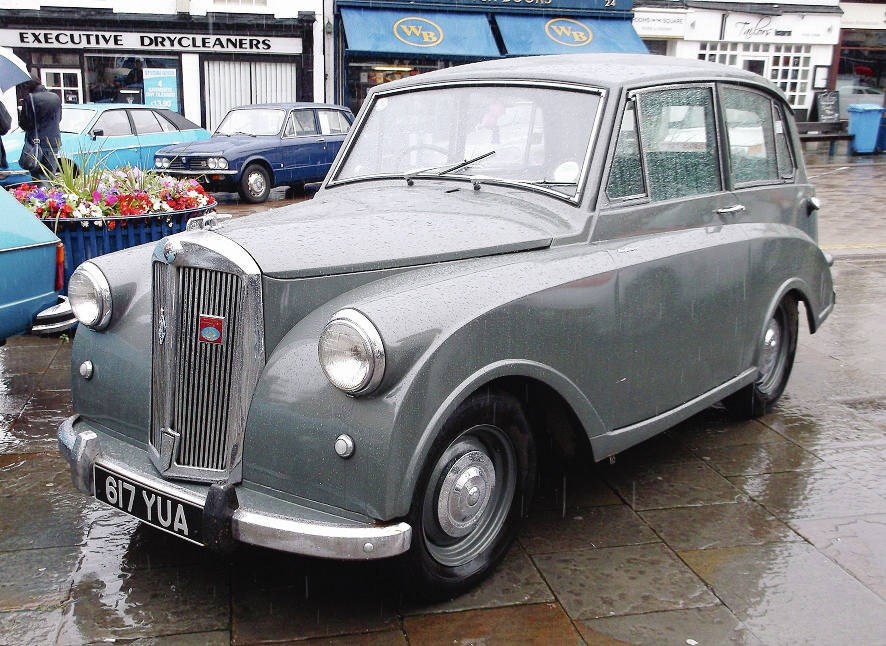The British Triumph gained its North American reputation principally through sports cars, starting with the popular TR series which extended from the 1953 TR2 all the way up to the V-8 powered TR8 in the early 1980s. There were also Spitfires and GTs, and even a few Stags.
Although best known for sports cars, Triumph also imported family cars. Among the non-sporty Triumphs the most distinctive was the little Mayflower two-door, four-passenger sedan that arrived in 1950. It is not remembered so much for its mechanicals or performance, both of which were rather ordinary, but for its unusual styling.
The Mayflower applied the classic British sharply creased “razor edge” design to a really small sedan (and a few convertibles). Razor edge styling made its world debut in about 1935 on the 3.5 litre English Bentley produced by coachbuilder Freestone & Webb.
Other Engllish coachbuilders such as Mulliner and Hooper soon followed, and before and after the Second World War such marques as Rolls-Royce, Daimler and Bentley had razor edge themes.
In North America it would make some brief appearances on the rear styling of the early 1980s Chrysler Imperial and second generation Cadillac Seville.
Triumph’s first postwar 1800 sedan introduced in 1946 also had razor edge lines but it was the Mayflower, designed and named for the North American market, that brought razor edge styling to the economy class.
The Mayflower idea had emerged as early as 1944 about the time the Standard Motor Co. was buying the financially stressed Triumph Motor Co. It was finally introduced in October, 1949.
This long gestation period was because Standard was preoccupied with building tractors for Harry Ferguson, and had also decided to concentrate on the new post-war government-inspired Vanguard sedan. Production of the Mayflower finally got under way in the summer of 1950.
With its sharply folded corners, traditional Triumph vertical bar grille and squared-off trunk the Mayflower was a pleasant design. It looked like a condensed version of the mid-sized Triumph 1800 sedan.
But like other shrunken models it couldn’t entirely escape looking a little like a caricature of the real thing, like those big Bentleys and Rolls-Royces. The Mayflower’s body was styled by Mulliner and built by Fisher and Ludlow, both of Birmingham.
Although the Mayflower had unit construction, which was an advanced feature for that time, and Triumph’s first, the rest of the Mayflower was pretty straightforward.
Power came from a 38 horsepower, side-valve, inline four cylinder engine of 1,247 cc (76 cu in.). It was a prewar design carried over from the Standard Ten, although now fitted with an aluminum cylinder head. The three speed fully synchronized, column shift transmission was donated by the Vanguard.
The Mayflower did, however, get its own independent coil spring front suspension, which would later find much more notoriety in the TR2 sports car.
The Mayflower was small with a 2,134 mm (84 in.) wheelbase and 3,912 mm (154 in.) length. Height and width were the same at 1,575 mm (62 in.) and it weighed about 907 kg (2,000 lb).
In spite of having only a three speed transmission when most small cars had four, the Mayflower, according to Mechanix Illustrated car tester Tom McCahill, turned in reasonable performance for an economy car.
In his December, 1952 road test, McCahill with his outrageous similes said the Mayflower had “… more acute angles than you can find in the uplift (bra) ads…” He also called its performance “no bolt of lightning,” reporting a zero to 97 km/h (60 mph) time of 26.3 seconds and a top speed of 105 to 113 km/h (65 to 70 mph). This was acceptable performance for an economy car of that time.
The Mayflower’s competitors according to Road & Track had even slower acceleration. The Hillman Minx took an interminable 40 seconds to 97 (60) and the Austin A40, 29.4 seconds. With top speeds of 117 (73) both were a little faster than the Mayflower.
McCahill was quite impressed with the “exceptionally fine handling” and the “light and sure” steering. While cornering was not in the MG class, it “held on like a tar stain on a white shirt.”
Despite its unusual styling, or perhaps because of it, the Mayflower sold modestly. It was produced only from 1950 to 1953 during which time some 35,000 were built.
Standard Motor Co. abandoned the Mayflower’s razor edge theme and went back to styling that was more rounded but far less distinctive.
The Triumph Mayflower had been a brief brave attempt to apply the classic styling normally associated with large, exclusive cars to a small economy sedan. Although almost certainly not a money-maker for Standard, it has a far better chance of being remembered than the nondescript little Standard econoboxes that followed it.
bvance1@cogeco.ca



